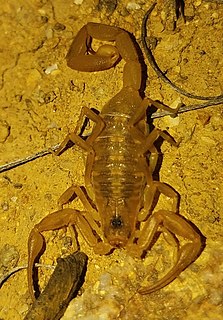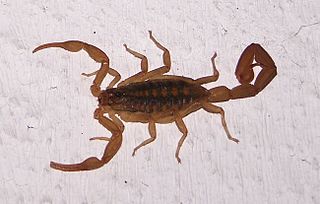
The Arizona bark scorpion is a small light brown scorpion common to the Sonoran Desert in the southwestern United States and northwestern Mexico. An adult male can reach 8 cm in length (3.14 inches), while a female is slightly smaller, with a maximum length of 7 cm (2.75 inches).

Centruroides exilicauda, the Baja California bark scorpion, is a species of bark scorpion found in Baja California. It is closely related to the Arizona bark scorpion, but is not considered dangerous. Previously only distinguished by geographic range, the two variants were classified in 1980 as the same species. Subsequently, differences in venom toxicity were recorded, and in 2004, DNA analysis showed them to be separate species.

Slotoxin is a peptide from Centruroides noxius Hoffmann scorpion venom. It belongs to the short scorpion toxin superfamily.

The striped bark scorpion is an extremely common scorpion found throughout the midsection of the United States and northern Mexico. It is perhaps the most frequently encountered scorpion in the U.S.

The Buthidae are the largest family of scorpions, containing about 96 genera and over 1230 species as of 2021. A few very large genera are known, but a high number of species-poor or monotypic ones also exist. New taxa are being described at a rate of several new species per year. They have a [cosmopolitan] distribution throughout tropical and subtropical environments worldwide. Together with four other families, the Buthidae make up the superfamily Buthoidea. The family was established by Carl Ludwig Koch in 1837.

Centruroides is a genus of scorpions of the family Buthidae. Several North American species are known by the common vernacular name bark scorpion. Numerous species are extensively found throughout the southern United States, Mexico, Central America, the Antilles and northern South America. Some are known for their interesting patterning or large size ; most if not all fluoresce strongly under ultraviolet illumination, except after moulting. They contain several highly venomous species, and fatalities are known to occur. The venom of the Mexican scorpion Centruroides limpidus limpidus contains the neurotoxins Cll1 and Cll2.

Centruroides limbatus is a species of bark scorpion from Central America. Its specific name "limbatus," is from the Latin meaning "black-edged," and refers to the darkly colored markings of this species.

Centruroides bicolor is a species of bark scorpion from Central America. Its specific name "bicolor" is from the Latin meaning "two colored" and refers to the markings of this species.

Centruroides gracilis is a species of scorpion in the family Buthidae, the bark scorpions. Its common names include Florida bark scorpion, brown bark scorpion, and slender brown scorpion. In Cuba it is known as alacran prieto and alacran azul. Contrary to one of its common names, it is not actually native to Florida in the United States. It is native to northern parts of the middle Americas, including Mexico, Guatemala, Belize, and Honduras. It is present in other parts as an introduced species, including Cuba, Panama, Colombia, Ecuador, Jamaica, and Florida in the United States. It is also introduced in parts of Africa, including Cameroon and Gabon, as well as the Canary Islands.
Centruroides robertoi is a species of scorpion in the family Buthidae.
Centruroides barbudensis is a species of scorpion in the family Buthidae.
Centruroides ornatus is a species of scorpion in the family Buthidae.
Centruroides baergi is a species of scorpion in the family Buthidae. They are commonly found in highlands and are almost exclusively found in the states of Oaxaca and southern Puebla, Mexico. C. baergi is the most abundant scorpion of the genus in the state of Oaxaca, making up a third of Centruroides reported between 2008 and 2014.
Ergtoxin is a family of toxins that can be isolated from the venom of several members of the Mexican scorpion genus of Centruroides. These toxins target hERG potassium channels.

Centruroides suffusus, the Mexican scorpion, is a species of scorpion in the family Buthidae.

Toxin Cll1 is a toxin from the venom of the Mexican scorpion Centruroides limpidus limpidus, which changes the activation threshold of sodium channels by binding to neurotoxin binding site 4, resulting in increased excitability.
C. elegans elegans may refer to :

Noxiustoxin (NTX) is a toxin from the venom of the Mexican scorpion Centruroides noxius Hoffmann which block voltage-dependent potassium channels and calcium-activated potassium channels.
Beta-mammal toxin Cn2, also known as Cn2 toxin, is a single chain β-scorpion neurotoxic peptide and the primary toxin in the venom of the Centruroides noxius Hoffmann scorpion. The toxin specifically targets mammalian Nav1.6 voltage-gated sodium channels (VGSC).
Beta-toxin Cll2, shortened to Cll2, is a toxin in the venom of the Mexican Scorpion species Centruroides limpidus limpidus. The toxin belongs to the β-class family of sodium channel-inhibiting scorpion toxins. It affects voltage-dependent activation, conductance and resurgent currents of voltage gated sodium channels by binding to site 4.










